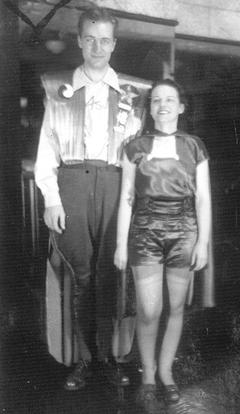Cosplay
Cosplay (a portmanteau of the words "costume" and "play") is a performance art in which participants, called cosplayers, wear costumes and fashion accessories to represent a specific character. Cosplayers often interact to create a subculture centered around role-playing. A broader use of the term "cosplay" applies to any costumed role-playing in venues apart from the stage, regardless of the cultural context.
History[edit | edit source]
The practice of dressing up as characters from fiction dates back to the early 20th century. The first documented instance of cosplay occurred at the 1st World Science Fiction Convention (Worldcon) in 1939, where Forrest J Ackerman and Morojo wore costumes inspired by the film Things to Come. The term "cosplay" was coined by Nobuyuki Takahashi of Studio Hard while attending the 1984 World Science Fiction Convention in Los Angeles, which he reported on in Japanese magazines.
Types of Cosplay[edit | edit source]
Cosplay can be categorized into several types, including:
- Anime and Manga Cosplay: Characters from anime and manga.
- Video Game Cosplay: Characters from video games.
- Comic Book Cosplay: Characters from comic books.
- Film and Television Cosplay: Characters from films and television series.
- Original Characters: Unique characters created by the cosplayers themselves.
Cosplay Culture[edit | edit source]
Cosplay has grown into a significant aspect of fan conventions and pop culture events worldwide. Major conventions such as Comic-Con International, Anime Expo, and Dragon Con feature cosplay prominently. Cosplayers often participate in contests, panels, and photoshoots.
Craftsmanship and Performance[edit | edit source]
Cosplay involves both craftsmanship and performance. Cosplayers often create their own costumes, which can involve sewing, prop making, and makeup. Performance aspects include posing for photographs, acting in character, and participating in skits or competitions.
Cosplay in Media[edit | edit source]
Cosplay has been featured in various forms of media, including television shows, documentaries, and web series. Shows like Heroes of Cosplay and Cosplay Melee have brought cosplay to a broader audience.
Community and Social Impact[edit | edit source]
The cosplay community is known for its inclusivity and supportiveness. It provides a creative outlet and a sense of belonging for many individuals. However, the community also faces challenges such as cosplay harassment and issues related to cultural appropriation.
See Also[edit | edit source]
References[edit | edit source]
External Links[edit | edit source]
Search WikiMD
Ad.Tired of being Overweight? Try W8MD's physician weight loss program.
Semaglutide (Ozempic / Wegovy and Tirzepatide (Mounjaro / Zepbound) available.
Advertise on WikiMD
|
WikiMD's Wellness Encyclopedia |
| Let Food Be Thy Medicine Medicine Thy Food - Hippocrates |
Translate this page: - East Asian
中文,
日本,
한국어,
South Asian
हिन्दी,
தமிழ்,
తెలుగు,
Urdu,
ಕನ್ನಡ,
Southeast Asian
Indonesian,
Vietnamese,
Thai,
မြန်မာဘာသာ,
বাংলা
European
español,
Deutsch,
français,
Greek,
português do Brasil,
polski,
română,
русский,
Nederlands,
norsk,
svenska,
suomi,
Italian
Middle Eastern & African
عربى,
Turkish,
Persian,
Hebrew,
Afrikaans,
isiZulu,
Kiswahili,
Other
Bulgarian,
Hungarian,
Czech,
Swedish,
മലയാളം,
मराठी,
ਪੰਜਾਬੀ,
ગુજરાતી,
Portuguese,
Ukrainian
Medical Disclaimer: WikiMD is not a substitute for professional medical advice. The information on WikiMD is provided as an information resource only, may be incorrect, outdated or misleading, and is not to be used or relied on for any diagnostic or treatment purposes. Please consult your health care provider before making any healthcare decisions or for guidance about a specific medical condition. WikiMD expressly disclaims responsibility, and shall have no liability, for any damages, loss, injury, or liability whatsoever suffered as a result of your reliance on the information contained in this site. By visiting this site you agree to the foregoing terms and conditions, which may from time to time be changed or supplemented by WikiMD. If you do not agree to the foregoing terms and conditions, you should not enter or use this site. See full disclaimer.
Credits:Most images are courtesy of Wikimedia commons, and templates, categories Wikipedia, licensed under CC BY SA or similar.
Contributors: Prab R. Tumpati, MD





